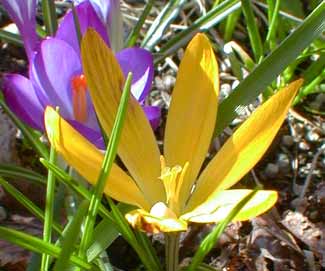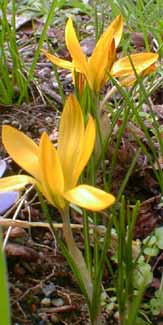 Crocus x luteus 'Stellaris'
Crocus x luteus 'Stellaris'
Yellow Crocus
"Make the golden crocus shine
Among the flowers most divine."
Charlotte Bronte
Recipient of the Award of Garden Merit, Crocus x luteus 'Stellaris' is an orange-yellow crocus with bronzy-brown streaks or "pencillings" on the outside of the petals. Its thin grassy leaves are four inches tall, sufficient to hold the flowers upright when planted in drifts alone, as opposed to amidst grass. They are sturdy enough to do well naturalized in lawns, but do even better if not competing with heavy turf.
The photo above taken in early March shows the Stellaris Yellow Crocus with a royal purple C. tommasinianus 'Ruby Giant' naturalized alongside it. We had a full drift of 'Stellaris' until a 'White Rosebud' Kehr Azalea was added to the array of shrubbery. Because most of the crocuses in this area are half-wild & have naturalized into a mixed grouping, I remember just kind of assuming I could install the little azalea without worrying which crocuses were in that one small spot. Come the crocus season, however, it was evident that I'd accidentally decimated the 'Stellaris' drift, which now pop up one here, one there, all around the edges of the azalea.
 An heirloom variety, 'Stellaris' has been in gardens since 1809. Edwardian crocus enthusiast E. A. Bowles noting "there is nothing like it nature" speculated rather fancifully that it might actually have been gardened a good deal longer than thought, identifying it with the so-called Crocus vernus vericolour pallideluteus described in 1629 by John Parkinson. It is in reality a hybrid of C. angustifolius the Cloth-of-Gold Crocus from the Crimean mountains, crossed with C. flavus (aka C. aureus) from Asia Minor.
An heirloom variety, 'Stellaris' has been in gardens since 1809. Edwardian crocus enthusiast E. A. Bowles noting "there is nothing like it nature" speculated rather fancifully that it might actually have been gardened a good deal longer than thought, identifying it with the so-called Crocus vernus vericolour pallideluteus described in 1629 by John Parkinson. It is in reality a hybrid of C. angustifolius the Cloth-of-Gold Crocus from the Crimean mountains, crossed with C. flavus (aka C. aureus) from Asia Minor. In our garden 'Stellaris' is in full bud late in February & in full bloom at February's end or the first week of March, though in colder areas they might not be in bloom until later in March.
'Stellaris' is supposed to have a faint lemony odor, but I've not been able to detect it. This drift is planted along the afternoon-sunny side of the Oyama magnolia against a picket fence. The large Oyama shrub is leafless when the crocuses are blooming, permitting them plenty of sunlight. The Kehr Azalea is evergreen, but for the moment too small to greatly overshadow anything.
An earlier yellow crocus naturalized from long ago has been identified as C. chyrsanthus 'Goldilocks' for which we have two drifts that begin blooming about three weeks earlier, then overlap for a week or two with 'Stellaris.' As these crocuses spread or get disrupted, it becomes rather difficult to tell the yellows apart, & I just end up reminding myself the 'Stellaris' are the ones that arrive a bit later, are furthest to the left along the fence, & tend to have pointier blooms & more subtle outer markings.
In addition to 'Goldilocks' & 'Ruby Giant,' 'Stellaris' shares its location with other long-naturalized crocuses including light blue (C. c. 'Pearl Blue'), palest yellow C. c. 'Cream Beauty' & so on. Among this group are some that start flowering earlier or later, & so finish flowering either later or earlier, insuring a very long duration for crocuses, from late January to the front edge of April, but most especially throughout February & March. The time-span would begin a bit later in cooler climates.